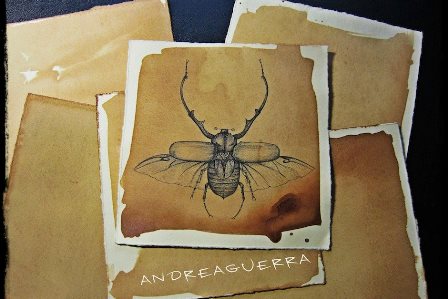
WTI Magazine #56 2015 March, 20
Author : Enrico De Iulis Translation by: John Cabot University
A wonderful iconographic branch about the form and beauty of insects is obtaining more and more success in the field of Italian Contemporary Art. Andrea Guerra, born in the region of Puglia, studies the physical feature of insects and their potential beauty. He describes them lean yet powerful, linear and clear as an architectural structure.
Guerra represents insects with intensive lines that remove out of the spectator's mind the idea of disgust yet evoke the perfection of their littleness allowing the viewer to appreciate and revalue them.
Guerra deals with zoological tables of other species although with entomology he shows his drawing skill in representing accurately even the keratin of tortoise shell and the down of their legs. The tables recall the XVI century iconographic art, of the late Renaissance, which leads until Darwin - although they maintain the perfect proportion of nature - focusing on the evolution either on biological aspect or on esthetic one.
Marcello Carrà brings his subject-insect up to an extreme level of attention; he fills up, cares about and decorates spaces, strengthening their surface, so that shells become a part of constructing Engineering, as well as the antennas as Mechanics and the wings as Aerodynamics. His Indian ink accentuates concavity and convexity, combining entomology to the art of design, furnishings or bodywork. The loss of size is the principal effect of Carrà's works. His drawings describe organisms that could be small as sprout or big as tank, both showing their beauty of leathery, series of plaques and caterpillars, always recalling their natural aspect.
Carrà's graphic experience is probably influenced by the drawing by Domenico Gnoli who was able to connect nature and imagination as well. Many times this special feature revokes a nightmare or a classical myth as could be a Sphinx or a Gorgon.
Aura Zecchini's subjects in her works, unlike to the description technique of the two previous artists, tend to flatten in the two dimensions starting to the original form of insects. This shape is an archetype to create arabesque overlapping, labyrinth of colorful sign and blades of grass that move around. The image that appears is a drawing repetition of a crawling lawn of life, flowers and wind represented as a texture of fabric.
The inspiration from the world of insects is certainly a frequent and used theme in the Art field. However, what is innovative and curious is the flourishing of new levels of analysis and elaboration by valid artists who combine the high expertise of lines with a fairy and mythological taste.



